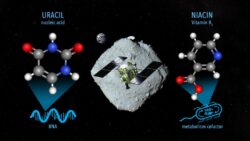Researchers found Uracil and Niacin or Vitamin B3 (Picture: Nasa Goddard/JAXA/Dan Gallagher/PA Wire)
Two organic compounds essential for living organisms have been found in samples from an asteroid, suggesting that some key ingredients for life were brought to Earth by space rocks billions of years ago.
An international team of experts, led by Professor Yasuhiro Oba in Japan analysed samples from Ryugu, an asteroid around 300 million kilometres from Earth.
The team found uracil, which is a nucleobase – one of the building blocks necessary to form RNA (molecules that contain instructions on how to build and operate living organisms).
The researchers said their findings, published in the journal Nature Communications, add to evidence that important building blocks for life could have been delivered to Earth by meteorites.
‘Scientists have previously found nucleobases and vitamins in certain carbon-rich meteorites, but there was always the question of contamination by exposure to the Earth’s environment,’ said the study’s leader Prof Oba, associate professor at Hokkaido University in Japan.
Ryugu is an asteroid around 300 million kilometres from Earth (Picture: AP)
The samples were brought to Earth on the Japanese spacecraft Hayabusa2.
‘Since the Hayabusa2 spacecraft collected two samples directly from asteroid Ryugu and delivered them to Earth in sealed capsules, contamination can be ruled out.’
Ryugu belongs to a class of asteroids called carbonaceous, or C-type, asteroids.
As well as uracil, the researchers also detected nicotinic acid – also known as Vitamin B3 or niacin – a key compound involved in metabolism in living organisms, alongside other nitrogen-containing organic compounds.
The researchers extracted these molecules by first soaking the Ryugu particles in hot water. The team then used various scientific techniques to analyse the chemical composition of these particles.
The samples were brought to Earth on the Japanese spacecraft Hayabusa2 (Picture: ISAS/JAXA via AP, File)
Prof Oba said that uracil was present in small quantities (between 6-32 parts per billion), while vitamin B3 was more abundant (around 49-99 parts per billion).
‘Other biological molecules were found in the sample as well, including a selection of amino acids, amines and carboxylic acids, which are found in proteins and metabolism, respectively,’ said Oba.
Last month, findings from the first Ryugu sample also revealed the presence of organic molecules, including amino acids. However, it did not include any RNA or DNA (molecules that carry genetic instructions in living organisms) components.
Prof Oba and his colleagues believe that the difference in concentrations in the two samples is maybe because they were collected from two different landing sites on Ryugu, which are thought to have different histories.
‘The discovery of uracil in the samples from Ryugu lends strength to current theories regarding the source of nucleobases in the early Earth,’ said Oba.
Meanwhile, scientists are also waiting to receive samples from another asteroid – Bennu – which is due to return this year as part of Nasa’s OSIRIS-REx mission.
‘Uracil is one of the building blocks of life and is found in RNA. The presence of nitrogen heterocycles in a fresh sample of the carbonaceous asteroid Ryugu is evidence that the starting materials for life were widespread in the early solar system,’ said Professor Mark Sephton at Imperial College London, who was not involved in the study.
‘Similar materials would have rained down on the early Earth and could have helped trigger the start of our planet’s biosphere.’
MORE : Valentine’s Day 2046 could be ruined by asteroid the size of Olympic pool
MORE : Stadium-sized asteroid to come within 2,000,000 kms of Earth
Uracil and Vitamin B3 were found on asteroid samples.





